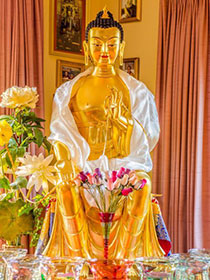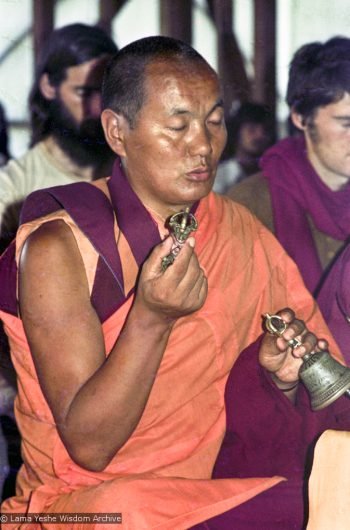The material objects you see on the altar and hanging on the walls of this meditation hall, these statues and thangkas, are symbolic. What do they symbolize? Wisdom, or understanding. Tibetan Buddhist psychology would say that these physical objects are talking to you beyond words.
Take my dorje and bell, for example. The person who created them had pure motivation, so they have a certain energy, what we might call “good vibrations.” This energy too communicates with us beyond words.
Similarly with pictorial representations of buddhas, bodhisattvas, realized lamas, yogis, and yoginis. Yoginis are sometimes shown as dancing—if you want to dance, realized dancing is OK! Anyway, such art also automatically transmits informational energy to your mind. Spiritual art gives you wisdom vibrations rather than the emotionally ignorant energy that ordinary art conveys.
You can see this even here. I think Westerners find this kind of thing easy to experience. For example, at this seminar you’re all sitting in the meditation posture for long periods of time, whereas at home you might find it difficult to sit like this for even five minutes. You’re surprising yourself: “In my life, I never thought I’d be able to sit this way!” Don’t you think that people new to this tradition might think like that? “I can’t believe I’m sitting cross-legged in this way. I never dreamed I’d be able to do that. But here I am at this meditation course doing it.”
This is partly because of the influence of the Buddha statue on the altar and the thangkas on the walls. You think, “He’s a human being; I’m a human being. He’s sitting like that; I can sit like that.”
Then there’s the female buddha, Tara. She’s an enlightened being with perfect power and perfect knowledge wisdom in female aspect, in a female body. She’s completely controlled; a female who has attained realizations equal to any male. So when women see her they think, “Wow, if she can become a buddha, so can I.”
Look, I can’t generalize, but I’ve heard many women say, “I can’t control my body; my energy’s too strong.” We always devalue ourselves like that. It’s a weak mind that does so and many women feel their mind is weak. They feel that they need somebody else to depend upon. Without grasping at another person they feel lonely and lost. This is symptomatic of the weak mind. As long as you’re on this earth, there’s no way to be lonely. You’re surrounded by all living beings. But when people—both men and women—are depressed, they do feel lonely because the lonely mind is unrealistic and emotional. So archetypal images of perfection are part of Lord Buddha’s psychology and really are very helpful.
Tourists come to the East and see Buddha statues and so forth in the temples and think that we believe that these material objects are God: “Buddhists worship graven images.” You can even read this in books. Isn’t that silly? We don’t believe that those material images are Buddha. They’re symbolic.
So you have to know this, otherwise you’ll get yourself into trouble. Mahayana art is not Buddha, Dharma, or Sangha. When we place light, incense, flowers, and so forth on the altar we’re not making offerings to the material objects there, we’re making offerings to the Buddha’s mind, his wisdom consciousness.
So it’s very good that you keep images of enlightened beings in your room. Just looking at them can give you control and everlasting peace. They give you positive imprints in your mind; they impart knowledge; they give you teachings. They’re like a full-time meditation course. So it’s very helpful for you to have holy objects in your room rather than ridiculous samsaric pictures polluting your mind.
Actually, when you go to your friends’ houses you can see what their interests are by the art on their walls and the way they decorate their rooms because what they do is a projection of their minds. You can see what trip they’re currently on, no matter what they say. People can talk all they want but what they actually do speaks louder than any words.
The way people put their lives together demonstrates whether they’re living with delusion or wisdom because it’s symbolic of their state of mind. You can see what’s going on in their mind because its vibration manifests externally.









